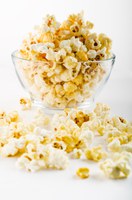Prairie Fare: Be Tech-savvy During National Nutrition Month
(Click an image below to view a high-resolution image that can be downloaded)
By Julie Garden-Robinson, Food and Nutrition Specialist
NDSU Extension
“Please come upstairs,” I texted to my 22-year-old daughter. “I need help!”
This was not an emergency situation. I was sitting with a pillow on my lap and four remote controls with more than 100 buttons.
I have been warned by my family not to push buttons randomly.
I had found the movie I wanted to watch. However, I could not figure out how to get the movie to play on our TV.
Our TV is a few years old, so it is not technically a “smart TV.” We had to buy a separate plug-in device to be able to access subscription movies. That added a fourth remote control.
I think I heard a sigh as my daughter walked down the hall.
“Why don’t you watch it downstairs?" she said. "It’s easy with the new TV."
“I like my chair up here.” I replied. “I will go and make popcorn and not stare at you.”
I thought back to my childhood when we had one TV with no remote control. I was a human remote control. I would turn the knob to get to one of the four channels we had available, if the weather conditions were right.
We had no cellphones or internet when I was young. I had my first personal computer in college.
Eventually, I enjoyed my movie, thanks to my techno-savvy, “digital native” daughter. She returned to the basement to video chat with her friends.
Technology certainly has made life easier in many respects. We have more information at our fingertips than ever. During the pandemic, even though we are not in the same room, we can see each other through Zoom or FaceTime or some other technology.
We also can vacuum our living room without lifting a finger using robotic vacuums. We can push a button to lock and unlock our doors if we have the right apps and devices.
Who knew that the predictions of the Jetson cartoon show would become reality?
As we enjoy our technology, we also may be bombarded with advertisements. We may encounter ads as we scroll through an online magazine or newspaper. We might be checking in with our friends on social media, such as Facebook (for those of us in the older generation, according to my kids).
As you peruse the web, you might be enticed by “click bait” that bring you to an advertisement. According to some estimates, we are exposed to at least 6,000 ads every day in various forms.
March is National Nutrition Month and also the beginning of the spring season. This has prompted a lot of weight loss advertisements. People are peeling off their sweaters and storing their parkas. They may discover the pandemic left them unable to fit into their spring wardrobe.
As you read information online or intersect with advertisements pulling you to websites, ask yourself these questions to determine if the information is reputable:
- Who is the author?
- What are the author’s credentials?
- Is a credible sponsoring institution identified?
- What is the purpose of the information?
- Is the site promoting or selling a particular product? (Commercial websites often end in “.com”)
- Is the information based on scientific research or opinion? (Government websites ending in “.gov” offer free information without commercial bias.)
- How current is the information? Is a date listed?
- Does the information have links to other sources of information? (This sometimes provides a clue to reliability, but not always. Anyone can link to another organization’s website.)
- Are the facts documented with sound scientific references? Or is the information solely based on personal testimonials?
- Does an editorial board oversee the content? What are their credentials?
- Is the information well-written in terms of grammar and spelling? What is the tone of the writing? Does it take a balanced approach?
Be a savvy consumer as you scroll around the information superhighway. Check out ad-free Extension resources from land-grant universities. See https://www.ag.ndsu.edu/nourishyourbody to view “Nourish and Exercise Your Body” from NDSU Extension. From getting sleep to managing stress to strengthening your muscles and heart, the site includes a wide variety of information to maintain your health and well-being based on research.
Here’s a crunchy snack to enjoy. Snacks can be high in fat, sodium and cost, depending on what you pick. Here’s a recipe courtesy of the Popcorn Board. Popcorn is a whole-grain snack. Even with added butter, this snack is fairly low in calories and fat. Using “powder” versions of spices (such as onion powder instead of onion salt) reduces the sodium content. If you want to reduce the calories more, use less butter.
Crunchy Cajun Popcorn
2 1/2 quarts popped popcorn (preferably air-popped)
1/4 c. butter, melted
1 tsp. paprika
1/2 tsp. onion powder
1/2 tsp. garlic powder
1 tsp. lemon pepper
Pour butter over warm popcorn. Combine remaining seasonings and sprinkle over popcorn; toss to mix.
Makes 10 cups of popcorn. Each cup has 70 calories, 5 grams (g) fat, 1 g protein, 7 g carbohydrate, 1 g fiber and 150 milligrams sodium.
(Julie Garden-Robinson, Ph.D., R.D., L.R.D., is a North Dakota State University Extension food and nutrition specialist and professor in the Department of Health, Nutrition and Exercise Sciences. Follow her on Twitter @jgardenrobinson)
NDSU Agriculture Communication - March 4, 2021
Source: Julie Garden-Robinson, 701-231-7187, julie.garden-robinson@ndsu.edu
Editor: Ellen Crawford, 701-231-5391, ellen.crawford@ndsu.edu




